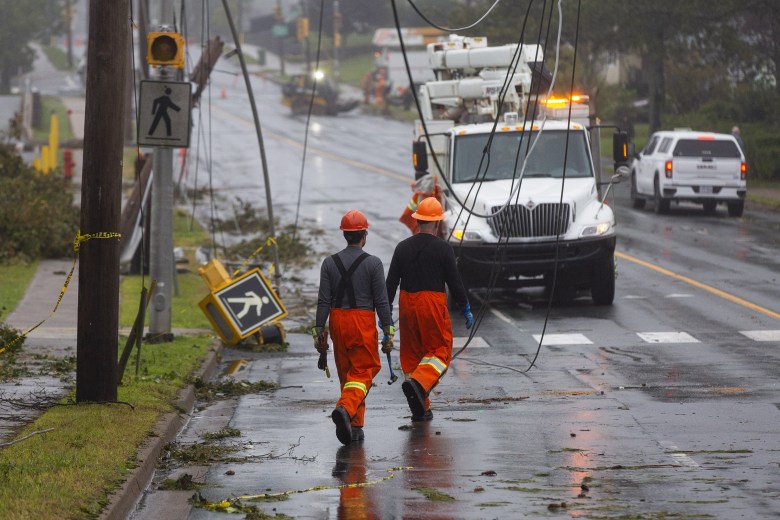Power rates in Nova Scotia are now expected to rise 13.8% over the next two years, beginning January 1, 2023.
That’s pending approval by the regulator, the Nova Scotia Utility and Review Board, after a deal was hashed out among the power company and lawyers representing consumers, small business, environmentalists, low-income residents, and large manufacturers.
The nine-page settlement agreement was released by Nova Scotia Power after stock markets closed yesterday.
There is no discussion about how the conclusions were reached and comments from the participants are likely to be few until the UARB approves or rejects the settlement. Here’s what Nova Scotia Power president Peter Gregg said in the release:
There’s no question this is a hard time for Nova Scotians and great attention must be paid to the current concerns over the rising cost of living, while also ensuring we maintain the most basic needs for a reliable electrical system. We appreciate the collaboration of customer representatives to reach the proposed settlement filed today, as we adhere to the direction provided by the provincial government through Bill 212.
What’s known as a settlement agreement was reached between Nova Scotia Power and the following intervenors in discussions behind closed doors:
- Consumer Advocate
- Small Business Advocate
- Industrial Group
- Dalhousie University
- Ecology Action Centre
- Affordable Energy Coalition
- Municipal Electric Utilities (Berwick Electric Commission, Riverport Electric Light Commission, Town of Mahone Bay, Town of Antigonish)
More costs to follow
Although details are scant, it’s clear that the 6.9% increase for residential customers in 2023 and 6.8% increase in 2024 does not include fuel costs that will be incurred in 2024.
Hundreds of millions of dollars will still need to be collected from ratepayers through a process known as the Fuel Adjustment Mechanism, which will result in a separate charge on the power bill in both 2024 and 2025.
There is no indication in the Settlement Agreement how much more consumers can expect to pay each month by 2024.
At one point this fall, Gregg suggested it could be in the range of an extra $15 a month, but no information on that point is contained in the actual settlement agreement.
Storm costs

The agreement does contain a new provision called a “storm rider” that Nova Scotia Power requested to reduce its costs related to restoring service after big storms such as Juan, Dorian, and Fiona.
Nova Scotia Power estimates its bill for Fiona will be in the range of $48 million, most of which will be charged to shareholders.
Climate change is expected to make storms not only more frequent but more severe. Starting next year, the storm rider will allow the power company to recover from ratepayers “prudent” costs over and above $10.2 million in 2023 and $10.4 million in 2024 and 2025.
The rider will end after 2025.
The agreement also contains a provision to set-up a De-Carbonization Deferral Account, which Nova Scotia Power suggested to help spread out the cost of paying to de-commission since coal-fired generating stations.
That’s another bill in the range of $700 million dollars that could come due over the next 7-10 years.
Intervenors agreed to establish the deferral account on the condition that a study be done to define and discuss what costs should be included to avoid giving Nova Scotia Power a blank cheque.
The residential customer charge, a line on the bill which pays for fixed costs, will be $19.17 a month rather than the $22 requested by the power company.
How we got here
Nova Scotia Power made an application in January for a 10.2% increase in power rates over three years; it did not include rapidly rising fuel costs for 2023 and 2024.
By October, the company filed additional information showing projected fuel costs had risen by one-third, to $681.5 million, for the three-year period covered by the rate application. Unless some portion of fuel costs were kicked down the road to be paid later, residents were looking at roughly a 26% increase on the power bill over the next two years.
On October 18, the Houston government stepped in and introduced legislation restricting increases to the half of the power bill which does not cover fuel expenses. Nova Scotia Power was told it could not raise rates by more than 1.8% over two years and that revenue amount of $137 million must be used to ensure “reliability” and fund energy efficiency programs.
The government also passed legislation restricting to 9% the profit Nova Scotia Power can earn each year, denying a request that would have allowed the company to earn 9.5% and keep all its over-earnings.
What’s next
The regulator must decide whether to approve all or part of the agreement negotiated between Nova Scotia Power and various lawyers representing different types of ratepayers.
It remains to be seen whether Nova Scotia Power will cut or proceed with $500 million in planned capital investments in new wind farms and battery storage projects over the next two years to help green the grid.
The two-year cap on rates legislated by the province essentially removed more than $100 million worth of revenue Nova Scotia Power had expected to get from ratepayers.


Mr. Houston I respectfully ask you please stop with your helping Nova Scotians
1) NSP – Annual increases of at least 7% for the next 2 years (depending on storms)
2) Carbon Tax- increases Canada Day July 1,2023, for heating oil and gas plus additional revenue for the province when the provincial portion of HST applied and kept by the province
3) NS Health – over 100,000 without a primary health professional
4) The non-indexing of personal tax exemptions for Nova Scotians
Mr. Premier please stop we cannot afford to keep paying for your help!!!
Terry French
HST is not charged on heating oil. GST at 5% is charged on heating oil.